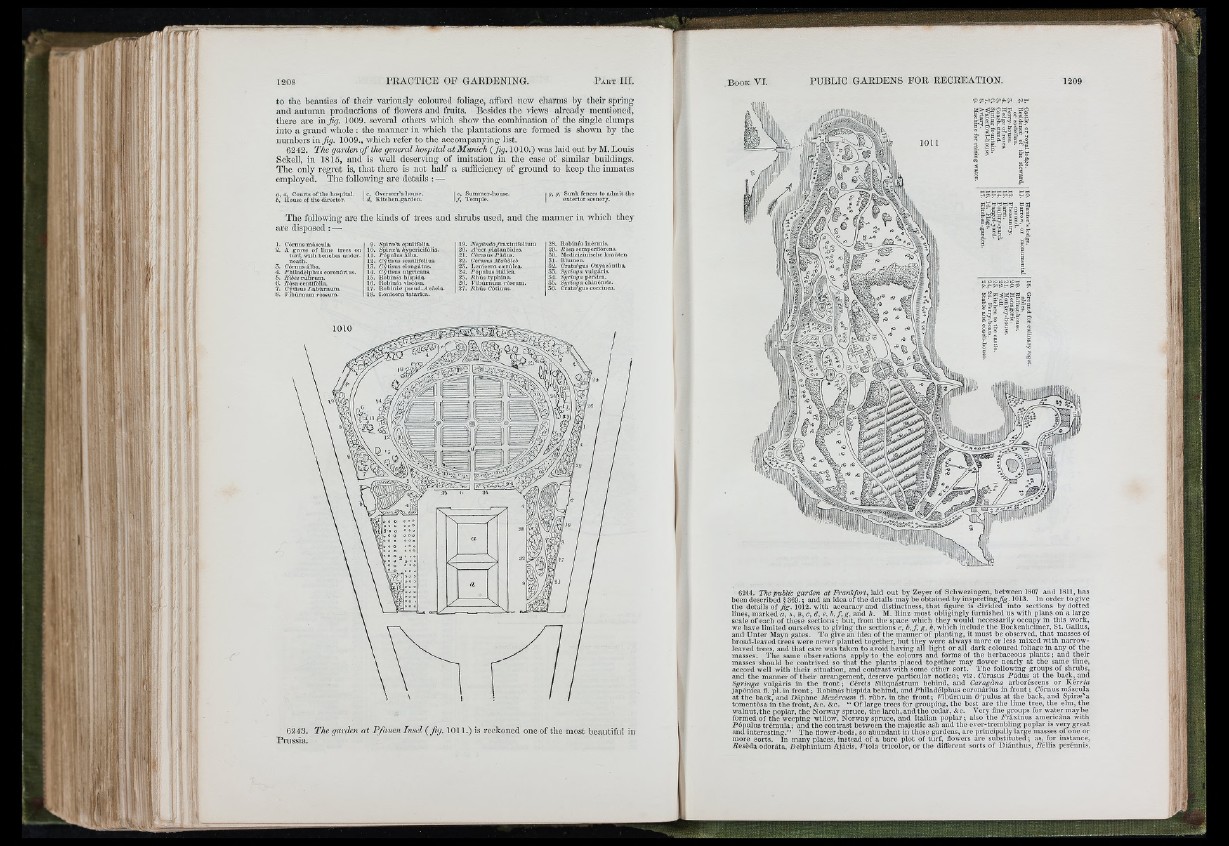
W f f T
; ll
r f
to tlie beauties of their vaiiously coloured foliag-e, afford new charms liy tlieir spring
and autumn productions of flowers and fmits. Besides tho views already mentioned,
tliere are in Jig. 1009. several others which show the combination of the single clumps
into a grand wliole : the manner in wliich the plantations arc formed is shown hy the
numbers in/p. 1009., which refer to the accompanying list.
6242, The garden o f the genei'ol hospital at Munich (Jig. 1010.) was laid out by M. Louis
Sckell, in 1815, and is well deserving of imitation in the case of similar buildmgs.
The only regi-ct is, that there is not half a sufficiency of ground to keep the inmates
employed. The following are details : —
The following arc the kinds of trees and shrubs used, and tho manner in which they
aro disposed: —
1. Cómus m.tscHla.
2. A grove of lime trees on
turf, with beiiolies underneath.
5. Córnus Alba.
4. Philadélplius coronàrius.
5. J?16es rùbrura.
6. Pòsa centifòlia.
7. Cytisus Xabùrnuni.
8. Fibùruum ròseum.
9. 5'pìrte'a opulifòlia.
10. iSpirtc'a Ayiicricifòlia.
11. Pópulus àlba.
12. Cytisus sessilifòlius.
13. Cytisus elongàtus.
14. Cytisus nigricans.
15. Robinia hispida.
16. Robinia viscósa.
17. Robinia pscud-Acàcia.
18. I.ouicero tataricii.
19. JVcpSncio/raxiuifùliuin
20. A'ccr jjlatanôïdcs.
21. Cérasus Pàdus.
22. Cérasus MaliìUeb
23. Lonicera crerùlea.
24. 2'ó])ulus itàlica.
25. Phùs typhina.
26. Fibùrnum ròseum.
27. Phùs Cótinus.
28. Robinia inérmis.
29. Pòsa semperflòrens.
30. Mediciziiiisclic kraiitcn-
31. Blumen.
6243. The garden nt P fa n en ln sd ( fg. 1011.) is reckoned oneof the most beautiful in
Priis.sia.
m i ï h s
à » P'S • i l l . "
S. §!■ ? - r é
S i m
S'S
6244. The public garden at Frankfort, laid out by Zeyer of Schwezingen, between 1807 and 1811, has
been described § 369.; and an idea of the details may be obtained by inspectingj%. 1013. In order to give
the details of fig . 1 012 . with accuracy and distinctness, that figure is divided into sections by dotted
lines, marked a, a , b, c, d, e, b ,f, g, and k. M. llinz most obligingly furnished us with plans on a large
scale of each of these sections; but, from th e space which they would necessarily occupy in this work,
we have limited ourselves to giving th e sections e, b ,f, g, A, which include the Bockenheimer, St. Gallus,
and Unter Mayn gates. To give an idea of th e manner of planting, it must be observed, that masses of
broad-leaved trees were never planted together, but they were always more or less mixed with narrowleaved
trees, and that care was taken to avoid having all light or all dark coloured foliage in any of the
masses. T h e same observations apply to th e colours and forms of the herbaceous plants; and their
masses should be contrived so that the plants placed together may flower nearly a t th e same time.
. * .O . .. V.JIOT OT OT 1 OT.OT OT OT...- OTOT.....—, ——-------- ~----^
japónica fl. pi. in front ; Robinia híspida behind, and Fhiladelphus coronàrius in front ; Cornus mascula
at th e back, and Daphne Mezèreum fl. rù b r. in th e fro n t; Fibùrnum O'pulus at the back, and Spirre a
tomentósa in the front, &c. &c. “ Of large trees for grouping, the best are th e lime tree, the elm, the
walnut, the poplar, th e Norway spruce, the larch, and the cedar, &c. Very fine groups for water maybe
formed of the weeping willow, Norway spruce, and Italian poplar ; also th e Fráxinus americàna with
Fopulus trèmula ; and the contrast between the majestic ash and the ever-trembling poplar is very great
1 intere sting.” ' The flower-beds, so abundant in these gardens, are principally large masses of one or
more sorts. In many places, instead of a bare plot of turf, flowers are substituted ; as, for instance,
Fesèda odoràta. Delphinium Ajàcìs, Fióla tricolor, or the diflercnt sorts of Diánthus, Déllis perénnis,